Financial Analysis: Ratio Analysis of Games Workshop PLC - Report
VerifiedAdded on 2022/10/04
|6
|1662
|322
Report
AI Summary
This report provides a comprehensive financial analysis of Games Workshop PLC, focusing on the application of ratio analysis to assess the company's creditworthiness and liquidity. The analysis begins with an explanation of how ratio analysis can be used to inform decisions about extending credit, particularly focusing on solvency ratios like the debt-equity ratio and interest coverage ratio. The report then delves into the significance of various financial ratios, including return on sales, asset utilization ratio, return on capital employed, current ratio, gearing, payables days, receivables days, and gross profit margin, explaining their relevance in determining a company's financial health and ability to meet its obligations. The report emphasizes the importance of comparing these ratios with industry averages and analyzing trends over time to gain a complete understanding of Games Workshop PLC's financial performance and risk profile. Finally, the report highlights how these ratios collectively offer insights into the company's short-term liquidity and long-term solvency, enabling informed decisions regarding potential business relationships.
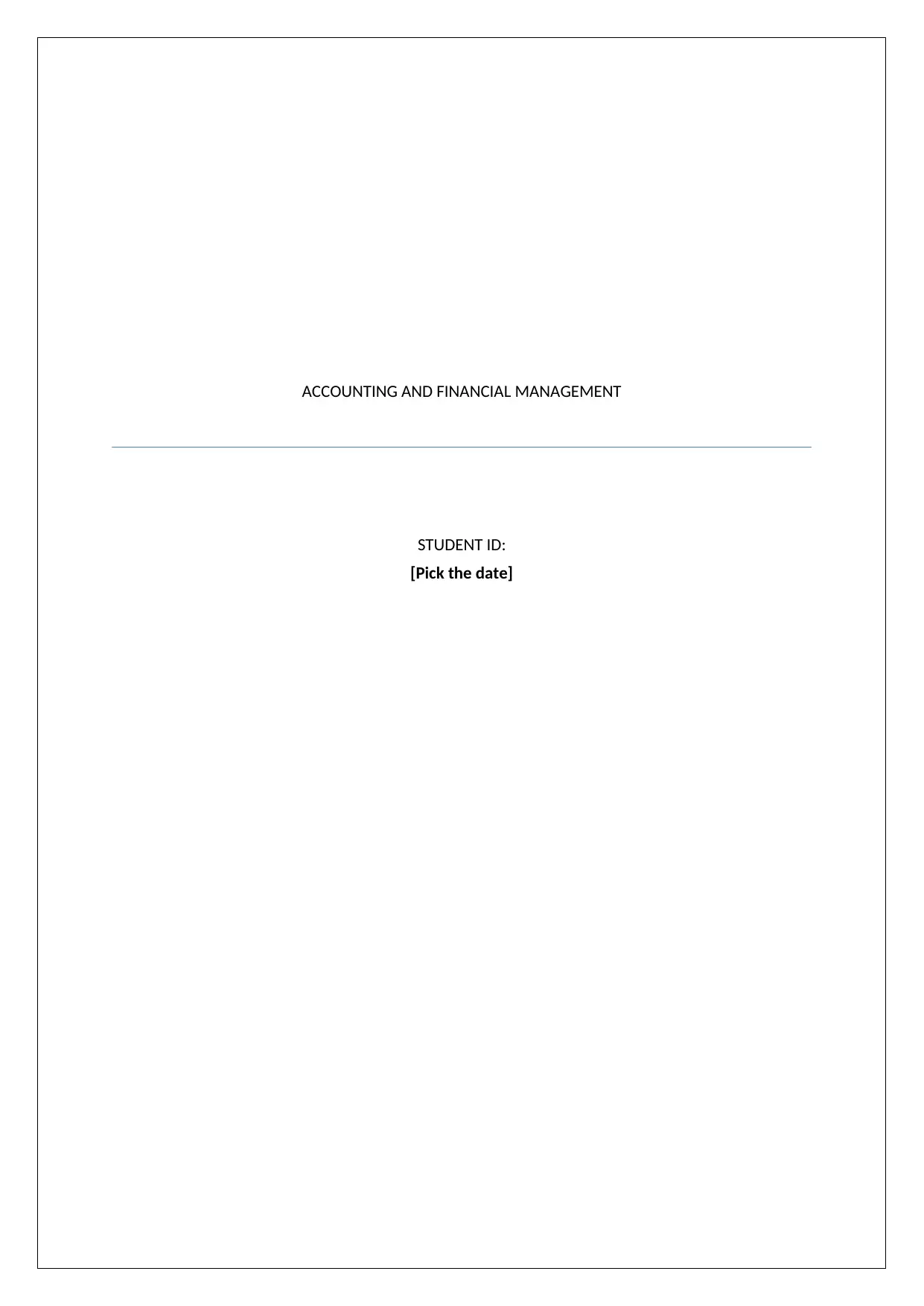
ACCOUNTING AND FINANCIAL MANAGEMENT
STUDENT ID:
[Pick the date]
STUDENT ID:
[Pick the date]
Paraphrase This Document
Need a fresh take? Get an instant paraphrase of this document with our AI Paraphraser
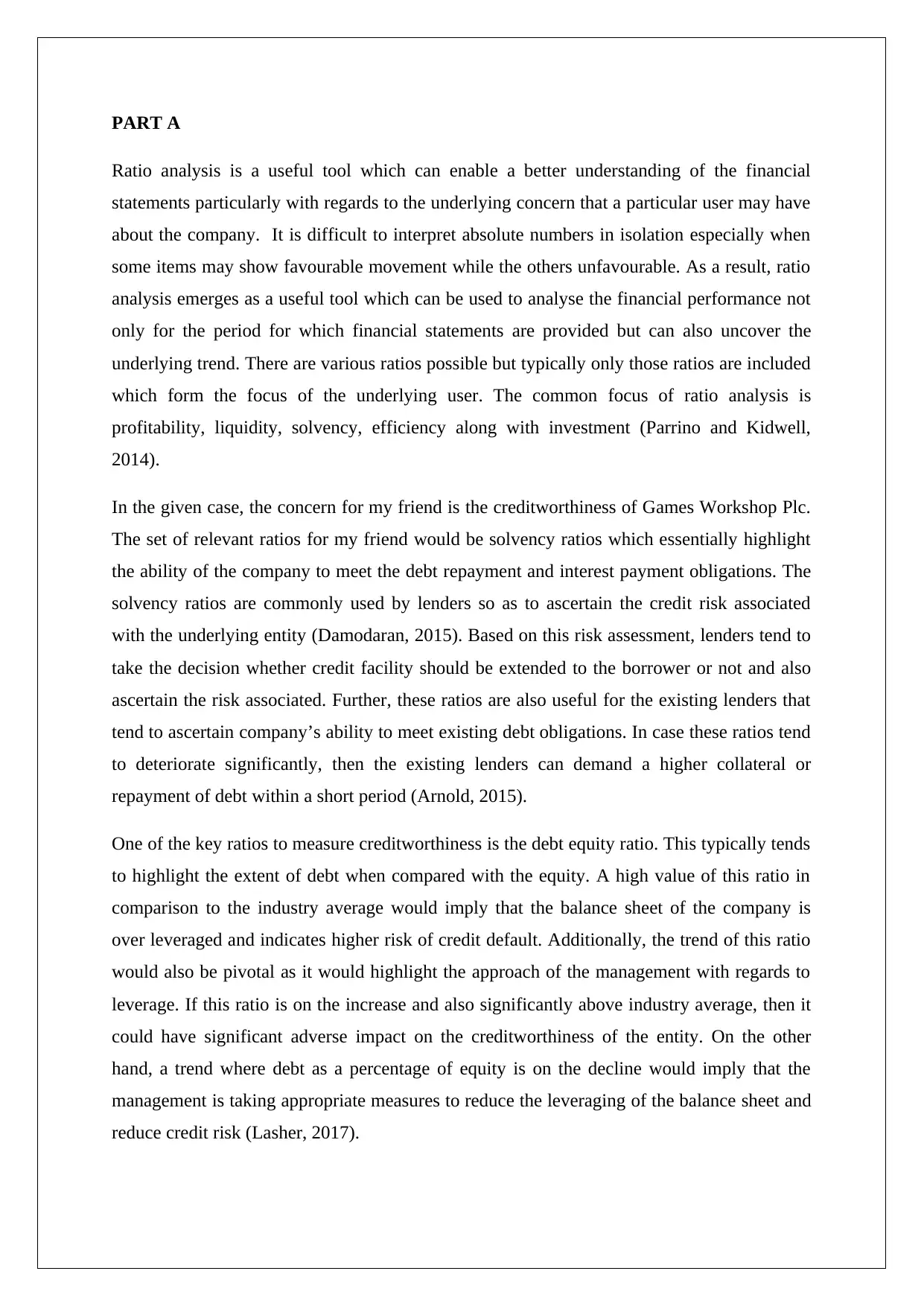
PART A
Ratio analysis is a useful tool which can enable a better understanding of the financial
statements particularly with regards to the underlying concern that a particular user may have
about the company. It is difficult to interpret absolute numbers in isolation especially when
some items may show favourable movement while the others unfavourable. As a result, ratio
analysis emerges as a useful tool which can be used to analyse the financial performance not
only for the period for which financial statements are provided but can also uncover the
underlying trend. There are various ratios possible but typically only those ratios are included
which form the focus of the underlying user. The common focus of ratio analysis is
profitability, liquidity, solvency, efficiency along with investment (Parrino and Kidwell,
2014).
In the given case, the concern for my friend is the creditworthiness of Games Workshop Plc.
The set of relevant ratios for my friend would be solvency ratios which essentially highlight
the ability of the company to meet the debt repayment and interest payment obligations. The
solvency ratios are commonly used by lenders so as to ascertain the credit risk associated
with the underlying entity (Damodaran, 2015). Based on this risk assessment, lenders tend to
take the decision whether credit facility should be extended to the borrower or not and also
ascertain the risk associated. Further, these ratios are also useful for the existing lenders that
tend to ascertain company’s ability to meet existing debt obligations. In case these ratios tend
to deteriorate significantly, then the existing lenders can demand a higher collateral or
repayment of debt within a short period (Arnold, 2015).
One of the key ratios to measure creditworthiness is the debt equity ratio. This typically tends
to highlight the extent of debt when compared with the equity. A high value of this ratio in
comparison to the industry average would imply that the balance sheet of the company is
over leveraged and indicates higher risk of credit default. Additionally, the trend of this ratio
would also be pivotal as it would highlight the approach of the management with regards to
leverage. If this ratio is on the increase and also significantly above industry average, then it
could have significant adverse impact on the creditworthiness of the entity. On the other
hand, a trend where debt as a percentage of equity is on the decline would imply that the
management is taking appropriate measures to reduce the leveraging of the balance sheet and
reduce credit risk (Lasher, 2017).
Ratio analysis is a useful tool which can enable a better understanding of the financial
statements particularly with regards to the underlying concern that a particular user may have
about the company. It is difficult to interpret absolute numbers in isolation especially when
some items may show favourable movement while the others unfavourable. As a result, ratio
analysis emerges as a useful tool which can be used to analyse the financial performance not
only for the period for which financial statements are provided but can also uncover the
underlying trend. There are various ratios possible but typically only those ratios are included
which form the focus of the underlying user. The common focus of ratio analysis is
profitability, liquidity, solvency, efficiency along with investment (Parrino and Kidwell,
2014).
In the given case, the concern for my friend is the creditworthiness of Games Workshop Plc.
The set of relevant ratios for my friend would be solvency ratios which essentially highlight
the ability of the company to meet the debt repayment and interest payment obligations. The
solvency ratios are commonly used by lenders so as to ascertain the credit risk associated
with the underlying entity (Damodaran, 2015). Based on this risk assessment, lenders tend to
take the decision whether credit facility should be extended to the borrower or not and also
ascertain the risk associated. Further, these ratios are also useful for the existing lenders that
tend to ascertain company’s ability to meet existing debt obligations. In case these ratios tend
to deteriorate significantly, then the existing lenders can demand a higher collateral or
repayment of debt within a short period (Arnold, 2015).
One of the key ratios to measure creditworthiness is the debt equity ratio. This typically tends
to highlight the extent of debt when compared with the equity. A high value of this ratio in
comparison to the industry average would imply that the balance sheet of the company is
over leveraged and indicates higher risk of credit default. Additionally, the trend of this ratio
would also be pivotal as it would highlight the approach of the management with regards to
leverage. If this ratio is on the increase and also significantly above industry average, then it
could have significant adverse impact on the creditworthiness of the entity. On the other
hand, a trend where debt as a percentage of equity is on the decline would imply that the
management is taking appropriate measures to reduce the leveraging of the balance sheet and
reduce credit risk (Lasher, 2017).
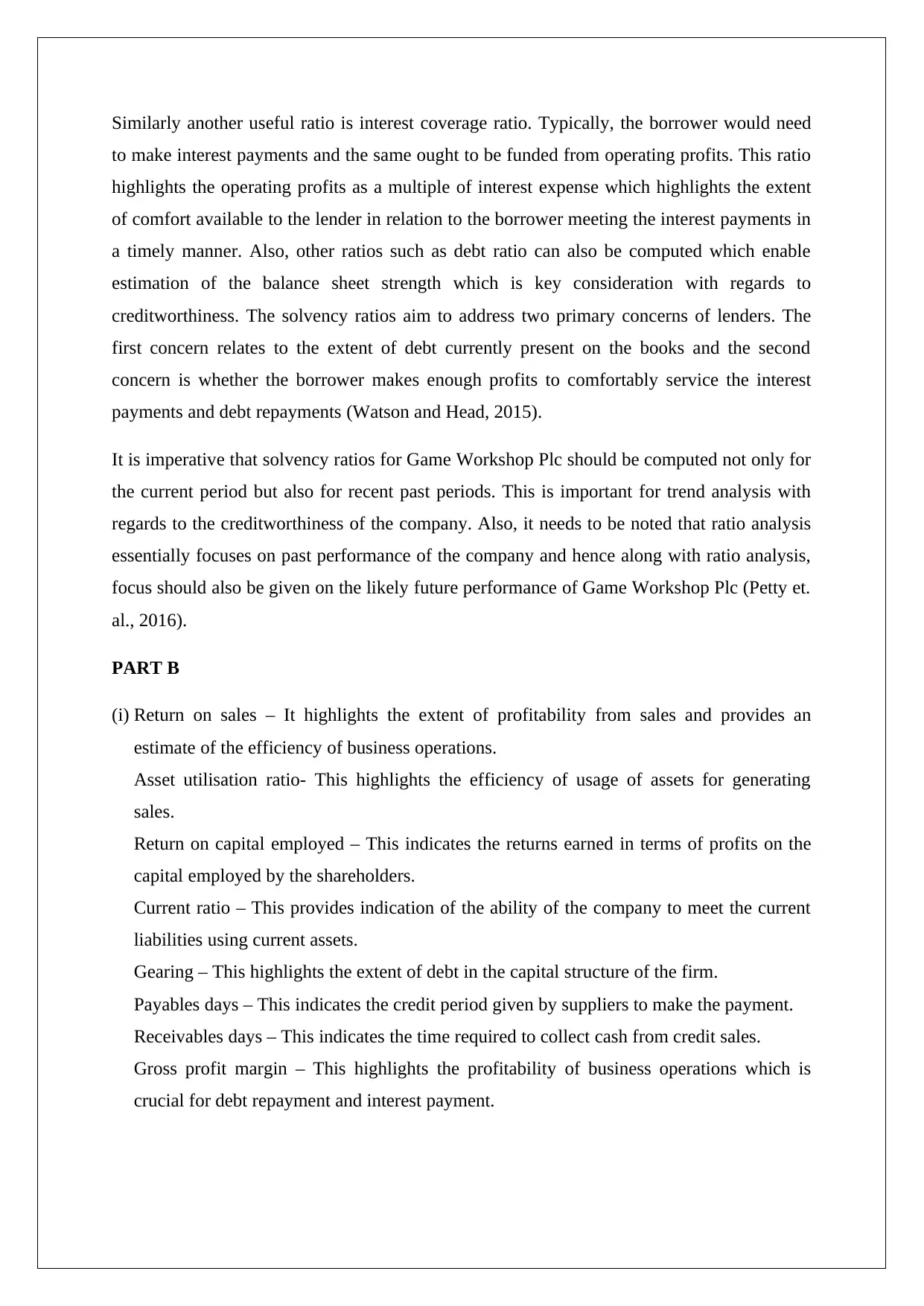
Similarly another useful ratio is interest coverage ratio. Typically, the borrower would need
to make interest payments and the same ought to be funded from operating profits. This ratio
highlights the operating profits as a multiple of interest expense which highlights the extent
of comfort available to the lender in relation to the borrower meeting the interest payments in
a timely manner. Also, other ratios such as debt ratio can also be computed which enable
estimation of the balance sheet strength which is key consideration with regards to
creditworthiness. The solvency ratios aim to address two primary concerns of lenders. The
first concern relates to the extent of debt currently present on the books and the second
concern is whether the borrower makes enough profits to comfortably service the interest
payments and debt repayments (Watson and Head, 2015).
It is imperative that solvency ratios for Game Workshop Plc should be computed not only for
the current period but also for recent past periods. This is important for trend analysis with
regards to the creditworthiness of the company. Also, it needs to be noted that ratio analysis
essentially focuses on past performance of the company and hence along with ratio analysis,
focus should also be given on the likely future performance of Game Workshop Plc (Petty et.
al., 2016).
PART B
(i) Return on sales – It highlights the extent of profitability from sales and provides an
estimate of the efficiency of business operations.
Asset utilisation ratio- This highlights the efficiency of usage of assets for generating
sales.
Return on capital employed – This indicates the returns earned in terms of profits on the
capital employed by the shareholders.
Current ratio – This provides indication of the ability of the company to meet the current
liabilities using current assets.
Gearing – This highlights the extent of debt in the capital structure of the firm.
Payables days – This indicates the credit period given by suppliers to make the payment.
Receivables days – This indicates the time required to collect cash from credit sales.
Gross profit margin – This highlights the profitability of business operations which is
crucial for debt repayment and interest payment.
to make interest payments and the same ought to be funded from operating profits. This ratio
highlights the operating profits as a multiple of interest expense which highlights the extent
of comfort available to the lender in relation to the borrower meeting the interest payments in
a timely manner. Also, other ratios such as debt ratio can also be computed which enable
estimation of the balance sheet strength which is key consideration with regards to
creditworthiness. The solvency ratios aim to address two primary concerns of lenders. The
first concern relates to the extent of debt currently present on the books and the second
concern is whether the borrower makes enough profits to comfortably service the interest
payments and debt repayments (Watson and Head, 2015).
It is imperative that solvency ratios for Game Workshop Plc should be computed not only for
the current period but also for recent past periods. This is important for trend analysis with
regards to the creditworthiness of the company. Also, it needs to be noted that ratio analysis
essentially focuses on past performance of the company and hence along with ratio analysis,
focus should also be given on the likely future performance of Game Workshop Plc (Petty et.
al., 2016).
PART B
(i) Return on sales – It highlights the extent of profitability from sales and provides an
estimate of the efficiency of business operations.
Asset utilisation ratio- This highlights the efficiency of usage of assets for generating
sales.
Return on capital employed – This indicates the returns earned in terms of profits on the
capital employed by the shareholders.
Current ratio – This provides indication of the ability of the company to meet the current
liabilities using current assets.
Gearing – This highlights the extent of debt in the capital structure of the firm.
Payables days – This indicates the credit period given by suppliers to make the payment.
Receivables days – This indicates the time required to collect cash from credit sales.
Gross profit margin – This highlights the profitability of business operations which is
crucial for debt repayment and interest payment.
⊘ This is a preview!⊘
Do you want full access?
Subscribe today to unlock all pages.

Trusted by 1+ million students worldwide
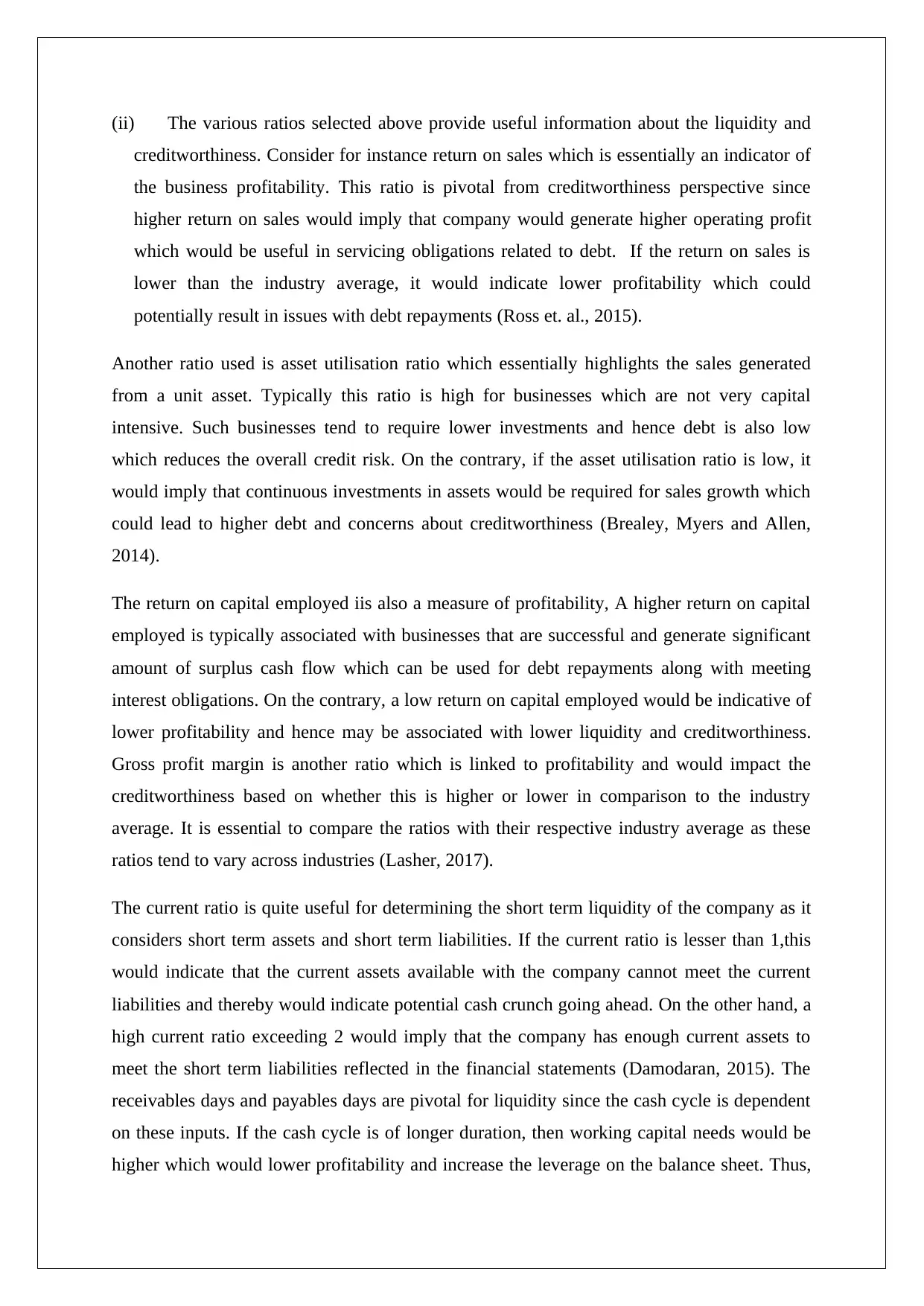
(ii) The various ratios selected above provide useful information about the liquidity and
creditworthiness. Consider for instance return on sales which is essentially an indicator of
the business profitability. This ratio is pivotal from creditworthiness perspective since
higher return on sales would imply that company would generate higher operating profit
which would be useful in servicing obligations related to debt. If the return on sales is
lower than the industry average, it would indicate lower profitability which could
potentially result in issues with debt repayments (Ross et. al., 2015).
Another ratio used is asset utilisation ratio which essentially highlights the sales generated
from a unit asset. Typically this ratio is high for businesses which are not very capital
intensive. Such businesses tend to require lower investments and hence debt is also low
which reduces the overall credit risk. On the contrary, if the asset utilisation ratio is low, it
would imply that continuous investments in assets would be required for sales growth which
could lead to higher debt and concerns about creditworthiness (Brealey, Myers and Allen,
2014).
The return on capital employed iis also a measure of profitability, A higher return on capital
employed is typically associated with businesses that are successful and generate significant
amount of surplus cash flow which can be used for debt repayments along with meeting
interest obligations. On the contrary, a low return on capital employed would be indicative of
lower profitability and hence may be associated with lower liquidity and creditworthiness.
Gross profit margin is another ratio which is linked to profitability and would impact the
creditworthiness based on whether this is higher or lower in comparison to the industry
average. It is essential to compare the ratios with their respective industry average as these
ratios tend to vary across industries (Lasher, 2017).
The current ratio is quite useful for determining the short term liquidity of the company as it
considers short term assets and short term liabilities. If the current ratio is lesser than 1,this
would indicate that the current assets available with the company cannot meet the current
liabilities and thereby would indicate potential cash crunch going ahead. On the other hand, a
high current ratio exceeding 2 would imply that the company has enough current assets to
meet the short term liabilities reflected in the financial statements (Damodaran, 2015). The
receivables days and payables days are pivotal for liquidity since the cash cycle is dependent
on these inputs. If the cash cycle is of longer duration, then working capital needs would be
higher which would lower profitability and increase the leverage on the balance sheet. Thus,
creditworthiness. Consider for instance return on sales which is essentially an indicator of
the business profitability. This ratio is pivotal from creditworthiness perspective since
higher return on sales would imply that company would generate higher operating profit
which would be useful in servicing obligations related to debt. If the return on sales is
lower than the industry average, it would indicate lower profitability which could
potentially result in issues with debt repayments (Ross et. al., 2015).
Another ratio used is asset utilisation ratio which essentially highlights the sales generated
from a unit asset. Typically this ratio is high for businesses which are not very capital
intensive. Such businesses tend to require lower investments and hence debt is also low
which reduces the overall credit risk. On the contrary, if the asset utilisation ratio is low, it
would imply that continuous investments in assets would be required for sales growth which
could lead to higher debt and concerns about creditworthiness (Brealey, Myers and Allen,
2014).
The return on capital employed iis also a measure of profitability, A higher return on capital
employed is typically associated with businesses that are successful and generate significant
amount of surplus cash flow which can be used for debt repayments along with meeting
interest obligations. On the contrary, a low return on capital employed would be indicative of
lower profitability and hence may be associated with lower liquidity and creditworthiness.
Gross profit margin is another ratio which is linked to profitability and would impact the
creditworthiness based on whether this is higher or lower in comparison to the industry
average. It is essential to compare the ratios with their respective industry average as these
ratios tend to vary across industries (Lasher, 2017).
The current ratio is quite useful for determining the short term liquidity of the company as it
considers short term assets and short term liabilities. If the current ratio is lesser than 1,this
would indicate that the current assets available with the company cannot meet the current
liabilities and thereby would indicate potential cash crunch going ahead. On the other hand, a
high current ratio exceeding 2 would imply that the company has enough current assets to
meet the short term liabilities reflected in the financial statements (Damodaran, 2015). The
receivables days and payables days are pivotal for liquidity since the cash cycle is dependent
on these inputs. If the cash cycle is of longer duration, then working capital needs would be
higher which would lower profitability and increase the leverage on the balance sheet. Thus,
Paraphrase This Document
Need a fresh take? Get an instant paraphrase of this document with our AI Paraphraser
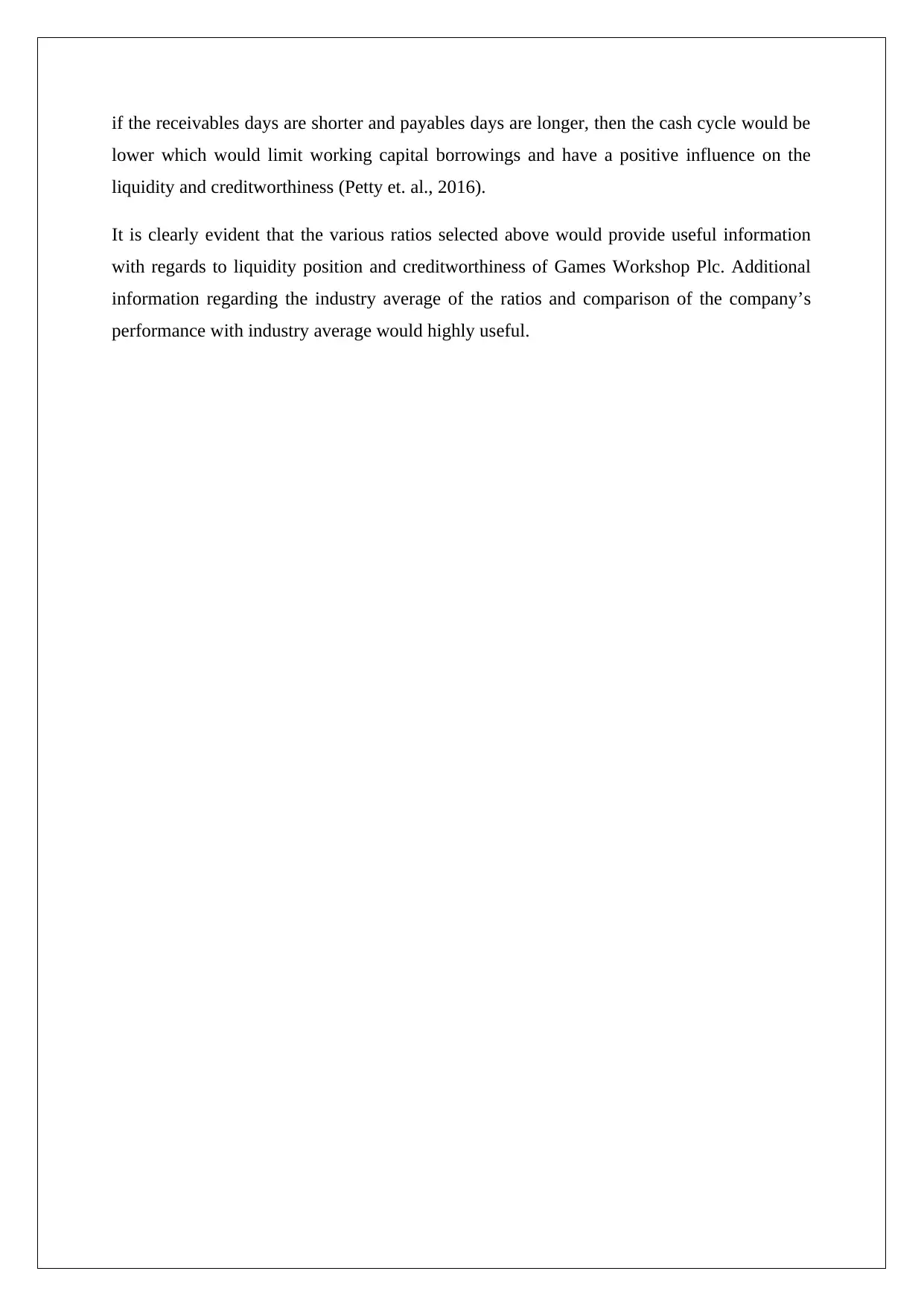
if the receivables days are shorter and payables days are longer, then the cash cycle would be
lower which would limit working capital borrowings and have a positive influence on the
liquidity and creditworthiness (Petty et. al., 2016).
It is clearly evident that the various ratios selected above would provide useful information
with regards to liquidity position and creditworthiness of Games Workshop Plc. Additional
information regarding the industry average of the ratios and comparison of the company’s
performance with industry average would highly useful.
lower which would limit working capital borrowings and have a positive influence on the
liquidity and creditworthiness (Petty et. al., 2016).
It is clearly evident that the various ratios selected above would provide useful information
with regards to liquidity position and creditworthiness of Games Workshop Plc. Additional
information regarding the industry average of the ratios and comparison of the company’s
performance with industry average would highly useful.
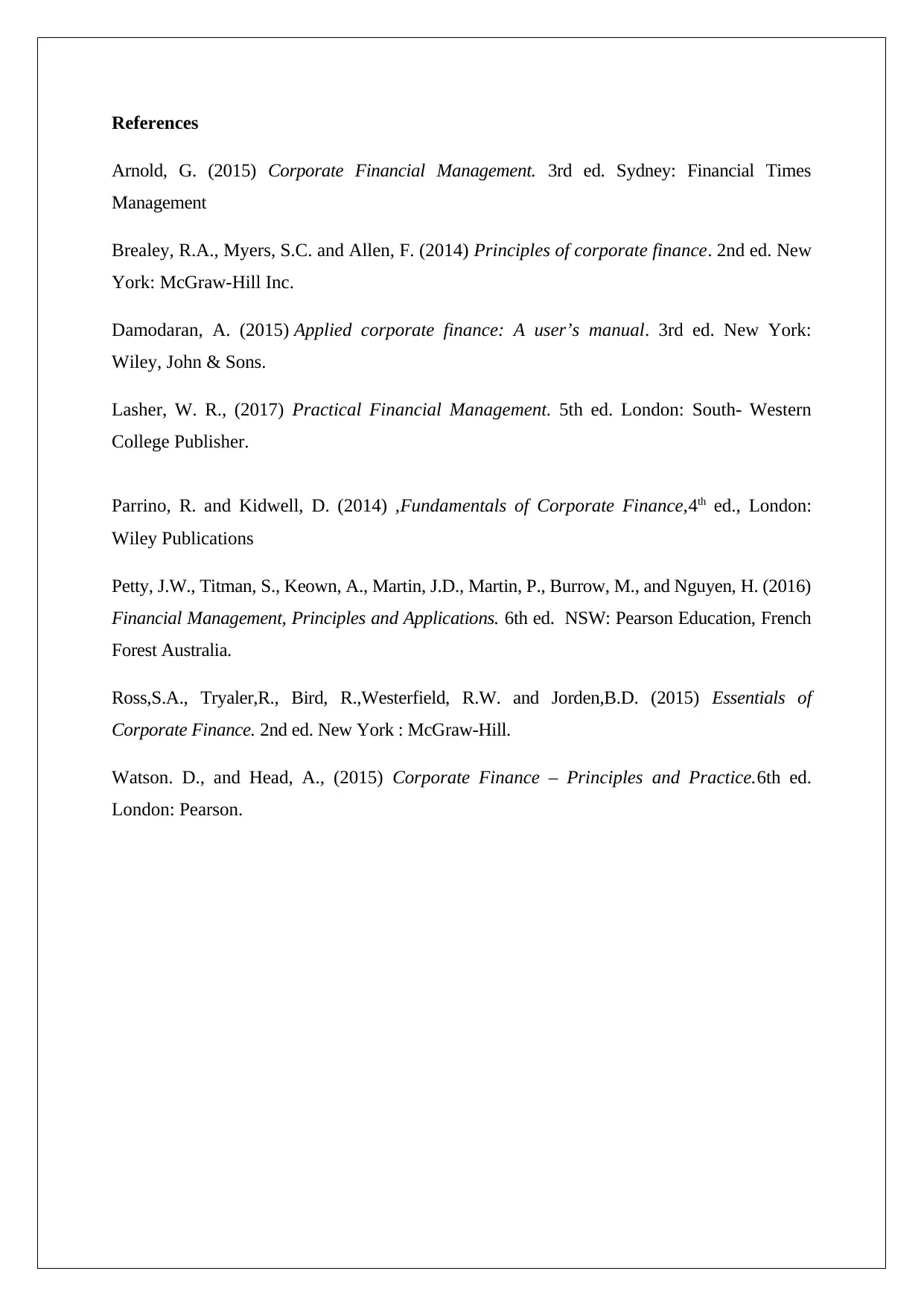
References
Arnold, G. (2015) Corporate Financial Management. 3rd ed. Sydney: Financial Times
Management
Brealey, R.A., Myers, S.C. and Allen, F. (2014) Principles of corporate finance. 2nd ed. New
York: McGraw-Hill Inc.
Damodaran, A. (2015) Applied corporate finance: A user’s manual. 3rd ed. New York:
Wiley, John & Sons.
Lasher, W. R., (2017) Practical Financial Management. 5th ed. London: South- Western
College Publisher.
Parrino, R. and Kidwell, D. (2014) ,Fundamentals of Corporate Finance,4th ed., London:
Wiley Publications
Petty, J.W., Titman, S., Keown, A., Martin, J.D., Martin, P., Burrow, M., and Nguyen, H. (2016)
Financial Management, Principles and Applications. 6th ed. NSW: Pearson Education, French
Forest Australia.
Ross,S.A., Tryaler,R., Bird, R.,Westerfield, R.W. and Jorden,B.D. (2015) Essentials of
Corporate Finance. 2nd ed. New York : McGraw-Hill.
Watson. D., and Head, A., (2015) Corporate Finance – Principles and Practice.6th ed.
London: Pearson.
Arnold, G. (2015) Corporate Financial Management. 3rd ed. Sydney: Financial Times
Management
Brealey, R.A., Myers, S.C. and Allen, F. (2014) Principles of corporate finance. 2nd ed. New
York: McGraw-Hill Inc.
Damodaran, A. (2015) Applied corporate finance: A user’s manual. 3rd ed. New York:
Wiley, John & Sons.
Lasher, W. R., (2017) Practical Financial Management. 5th ed. London: South- Western
College Publisher.
Parrino, R. and Kidwell, D. (2014) ,Fundamentals of Corporate Finance,4th ed., London:
Wiley Publications
Petty, J.W., Titman, S., Keown, A., Martin, J.D., Martin, P., Burrow, M., and Nguyen, H. (2016)
Financial Management, Principles and Applications. 6th ed. NSW: Pearson Education, French
Forest Australia.
Ross,S.A., Tryaler,R., Bird, R.,Westerfield, R.W. and Jorden,B.D. (2015) Essentials of
Corporate Finance. 2nd ed. New York : McGraw-Hill.
Watson. D., and Head, A., (2015) Corporate Finance – Principles and Practice.6th ed.
London: Pearson.
⊘ This is a preview!⊘
Do you want full access?
Subscribe today to unlock all pages.

Trusted by 1+ million students worldwide
1 out of 6
Related Documents
Your All-in-One AI-Powered Toolkit for Academic Success.
+13062052269
info@desklib.com
Available 24*7 on WhatsApp / Email
![[object Object]](/_next/static/media/star-bottom.7253800d.svg)
Unlock your academic potential
Copyright © 2020–2025 A2Z Services. All Rights Reserved. Developed and managed by ZUCOL.





